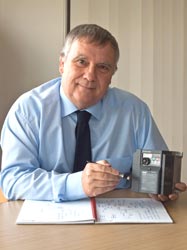
Posted to News on 2nd Oct 2010, 16:52
Regenerative inverter drives - applications and how they work
Jeff Whiting of Mitsubishi Electric explains how regenerative inverter drives can be applied in industrial environments to save energy and deliver additional operational benefits.

Historically in industry, an electric motor was started and left running throughout the working shift. There was often a good reason for this: starting motors usually took a large energy inrush until the motor got moving and built up its own resistance. This inrush could be up to 12 times the working current of the motor and, therefore, motors are usually rated with a number of direct starts allowed per hour. Leaving the motor running seemed quite a realistic approach. However, fitting a motor with an inverter offers a much softer starting regime and is far less restrictive in terms of the number of available starts. This creates an opportunity to only run the motor when required and to save significant energy by switching the motor off when not needed.
An inverter drive offers even more energy efficiency by optimising the energy used in the electric motor whatever the load, and also by running the process at lower speeds - which can save significant energy and costs. With a fan or pump, for example, a slight reduction in speed can cut the power consumption significantly.
The savings gained by using inverters in real terms are both financial and ecological. In fact it has been calculated that the CO2 savings made by the inverters sold in the UK each year relate to the CO2 used by 100,000 business cars doing normal mileage.
Regenerative drives
An inverter does not just save energy or enable a process to be optimised for changing loads and requirements; some industrial applications bring a number of other challenges that are easily addressed by today's high-performance inverter drives. Typical of these is where energy in the process overhauls the power of the motor. To keep the process under control, this energy must be dealt with and, if possible, used to power other parts of the production cycle.
To maintain continuous control under all load situations, an inverter has to not only drive a motor that is moving a load but also shed excess energy when the load is driving the motor (typically during deceleration). As this generated energy is in the form of electricity, it is often converted and dissipated as heat via braking resistors. However, a specially designed regenerative drive, such as Mitsubishi's Regenerative A701 drive, controls the load under all conditions and sheds the excess energy by converting the kinetic energy into electricity and injecting it safely into the mains or sharing it with other drives by connecting them together. Either way, energy will be saved and electricity costs will be reduced
The basic requirements of a soft start-up and stop can be programmed into a regenerative drive. Furthermore, running speeds can be reduced when demand is lower, thereby saving additional energy, or the motor can even be stopped if there is temporarily zero demand.
How regenerative drives work
Standard inverters drives have an input section, power reservoir and an output section. In general, they operate in such a way that energy can freely flow in both directions through the inverter (output) sections, but the input section is a diode bridge that only permits energy to flow in one direction.
Regenerative drives maintain the three sections but, to operate as a regenerative drive, the power needs to flow in both directions in the input section as well as the output section. This is achieved by merging two inverters back-to-back. The additional input inverter allows power to flow from the mains to the power reservoir when needed, and allows unimpeded reverse flow into the mains when the reservoir is above normal operating levels.
When the motor requires driving, the input inverter circuitry is automatically operated to allow the mains supply to pass through and maintain the power reservoir at the optimum condition. If the motor load overhauls the motor, the electric motor acts as a generator and energy is passed back through the output inverter section and begins to pump up the power reservoir. Under these conditions the regenerative drive switches the excess power using the input inverter action to return the excess energy to the mains. An important function of the input inverter is to synchronise the regenerated power with the phase rotation of the input phases.
Follow the link for more information about Mitsubishi's inverter drives.
Want the latest machine building news straight to your inbox? Become a MachineBuilding member for free today >>

















